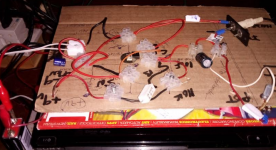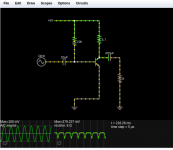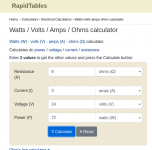When I built his circuit, I modified it.
I used Negative Feedback instead from Collector to Base of the transistor..
No Cap needed as the VDC out on collector is only 300mvolts.. and also there was sound and a amazing 1.89Volts RMS to a 4 ohm Speaker...
Not the sound which changed the world, but sound OK..
I used Negative Feedback instead from Collector to Base of the transistor..
No Cap needed as the VDC out on collector is only 300mvolts.. and also there was sound and a amazing 1.89Volts RMS to a 4 ohm Speaker...
Not the sound which changed the world, but sound OK..
It seems to be exactly like that..Which is what I suspect from Day 1 , and not only in this thread.
Just read some stuff on his Old similar thread,, he is working on this 5 years and the guys explained it very well
But he just went on the same way as did here..
I'm out here
The Beatles had fantastic Album LET IT BE..
I change the name to LET HIM BE..
Cheers guys..
He´s COUNTING on Forum Members noble impulse to help those in distress.
But when a lifesaver guy FAILS in saving a distressed swimmer in shark infested waters, seeing he is not interested in saving himself but ENJOYING all the Press, Cameras, attention, emotional reports, "breaking news" appearances, magazine cover pictures, etc. , and to boot does it 5 years in a row, with no signs of stopping, he can be forgiven for thinking this is all a setup.
**122 posts so far?**
Leading to NOTHING?
I must bow in admiration for a MASTER MANIPULATOR.
But when a lifesaver guy FAILS in saving a distressed swimmer in shark infested waters, seeing he is not interested in saving himself but ENJOYING all the Press, Cameras, attention, emotional reports, "breaking news" appearances, magazine cover pictures, etc. , and to boot does it 5 years in a row, with no signs of stopping, he can be forgiven for thinking this is all a setup.
**122 posts so far?**
Leading to NOTHING?
I must bow in admiration for a MASTER MANIPULATOR.
Thanks for all you help. I will post here when I get it working.
Whether you choose to believe it or not, I have learned a much from all of you, it just remains to build the thing.
On my part, reading advice carefully and performing practical experiments would have been better. After all everyone here is a serious builder, and it was inconsiderate of me not to value your time. I apologize for this.
Some of the contributors have not been too critical at all, however harsh criticism, like airbags (no offence intended) do save us from injury, although they be a little 'in your face'.
I will be communicating with the mods on the appropriate use of this forum.
It has been a costly education. Thank you again,
Whether you choose to believe it or not, I have learned a much from all of you, it just remains to build the thing.
On my part, reading advice carefully and performing practical experiments would have been better. After all everyone here is a serious builder, and it was inconsiderate of me not to value your time. I apologize for this.
Some of the contributors have not been too critical at all, however harsh criticism, like airbags (no offence intended) do save us from injury, although they be a little 'in your face'.
I will be communicating with the mods on the appropriate use of this forum.
It has been a costly education. Thank you again,
🙂

The helpful DiyA community for the fifty-eleventh time: "PICK THAT D@#N FU@K!NG 2N3055, NOW!!!"
Basic Conundrums: "nooo.. that's definitely not possible, becausssse....... it's not available at my local flea market.. however, I have one BC237 lying around, but unfortunately the emitter leg broke off right at the package junction when I desoldered it from an old scrapped transistor radio.. so I have to repair it first.. but that will take a few days..."
The little saga of a very basic 5 Watt amp project

The helpful DiyA community for the fifty-eleventh time: "PICK THAT D@#N FU@K!NG 2N3055, NOW!!!"
Basic Conundrums: "nooo.. that's definitely not possible, becausssse....... it's not available at my local flea market.. however, I have one BC237 lying around, but unfortunately the emitter leg broke off right at the package junction when I desoldered it from an old scrapped transistor radio.. so I have to repair it first.. but that will take a few days..."

The amplifier output is 'insufficient to drive a speaker' . A mini stereo output on a laptop at 100 -300 mV will drive a small speaker. The LM386 amplifier board puts out a modest 0.4 Watts of power if you can call it that. That is sufficient for my listening, however.
The LM386 IC Low Power Audio Amplifier - DIYODE Magazine
The MOSFET driven circuit described on a popular electronics channel puts out about 300 mW also.
Class A MOSFET amplifier using one transistor - with schematic - YouTube
It is demonstrated to drive speaker.
There is this:
Build this Amazingly simple class A amplifier - YouTube
I guess we are talking about low-class A.
I bought the TIP41A from a local supplier.
The Texas Instruments datasheet has no impedances listed for its graphs, but National Semiconductor’s shows that for a 12V supply, the LM386 can drive 0.4W into 8Ω before exceeding the maximum dissipation, or 0.3W into 4Ω.
The LM386 IC Low Power Audio Amplifier - DIYODE Magazine
The MOSFET driven circuit described on a popular electronics channel puts out about 300 mW also.
Class A MOSFET amplifier using one transistor - with schematic - YouTube
It is demonstrated to drive speaker.
There is this:
Build this Amazingly simple class A amplifier - YouTube
I guess we are talking about low-class A.
. it's not available at my local flea market.
I bought the TIP41A from a local supplier.
I’ll bet that LM386 will sound louder than what you put together initially, and uses 1/100th of the power.
All you need is
I followed John's advice and added a large 5W resistor between the collector and the power supply. Next I moved the capacitor and loudspeaker to connect to the ground and the collector.
Not wanting to take a chance, I used a 9V battery to power the circuit. Initially, after connecting a resistor incorrectly, I was able to get the thing working.
Back to sweet music, very low volume but listenable. I could not stop listening. I have gone through 3 CDs, and nothing is getting too hot. Measurements tomorrow, but it does produce music.
Thanks to John for his suggestion. Looks like I have a working thing here.
All your circuit requires is a resistor connected between the collector and supply. You can then rearrange the capacitor and loudspeaker to connect to ground.
If you operate the circuit at 9V the collector resistor - let's say 4.7 ohms - will drop about 5V across it. So your transistor will dissipate the remaining 4V multiplied by the current which will be just over 1A =4W. That makes it necessary to use a heatsink, but does not have to be particularly large if you don't mind the transistor getting a little warm (10C/W means a rise of 40 degrees C) but as with all components the cooler you run them the more reliable they will be. I's probably choose a 7C/W heatsink or maybe 5C/W. The resistor on the other hand will be dissipating 5W and should probably be a 10W component in free air or a metal cased 5W on a small heatsink too.
.........
I followed John's advice and added a large 5W resistor between the collector and the power supply. Next I moved the capacitor and loudspeaker to connect to the ground and the collector.
Not wanting to take a chance, I used a 9V battery to power the circuit. Initially, after connecting a resistor incorrectly, I was able to get the thing working.
Back to sweet music, very low volume but listenable. I could not stop listening. I have gone through 3 CDs, and nothing is getting too hot. Measurements tomorrow, but it does produce music.
Thanks to John for his suggestion. Looks like I have a working thing here.
I’ll bet that LM386 will sound louder than what you put together initially, and uses 1/100th of the power.
Yes Yes! But I did not build the LM386!.
Try 24 volts and 8 ohms into the collector and 1 ohm into the emitter. Select the correct bias current. 4700 uF electrolytic capacitor.
Last edited:
Watts up!
Yes, but the Wattage! 72 Watts through the thing and 3 Amps! The transistor can handle upto 4 A however the resistor will light up like a bulb. I will need an arrangement like in the ZCA with a whole roomful of resistors.
Power resistors: These look like the ones used by hpro in his tests.
Yes, but the Wattage! 72 Watts through the thing and 3 Amps! The transistor can handle upto 4 A however the resistor will light up like a bulb. I will need an arrangement like in the ZCA with a whole roomful of resistors.
Power resistors: These look like the ones used by hpro in his tests.
Attachments
Last edited:
In the collector a resistor is 8 ohm / 50W, in the emitter is 1 ohm / 5 watts, the output power is about 1.5 watts. Quiescent current 1.5 A. This is the price of class A.🙁
The cost of class A?
Cents per kilowatt hour in some United States states
New Jersey 16.78
New York 19.92
Pennsylvania 13.89
So if your amplifier consumes 20 watts running it for 4 hours a day for 1 year in New York will cost:
4x0.02x365x20 x 0.1992 = $ 5.8
The ZCA consumes:
A random search for a Pioneer Amplifier
nets Power Consumption: 460 W is this typical?
Meanwhile the cost of a burger is $9.
Cents per kilowatt hour in some United States states
New Jersey 16.78
New York 19.92
Pennsylvania 13.89
So if your amplifier consumes 20 watts running it for 4 hours a day for 1 year in New York will cost:
4x0.02x365x20 x 0.1992 = $ 5.8
The ZCA consumes:
I burn over 20 Watts to get only about 4.8 audio Watts per channel! The heatsink I used is rated at 0.784 °C/W
A random search for a Pioneer Amplifier
nets Power Consumption: 460 W is this typical?
Meanwhile the cost of a burger is $9.
Last edited:
Don´t get lured back into the crocodile pit. 😎Try 24 volts and 8 ohms into the collector and 1 ohm into the emitter. Select the correct bias current. 4700 uF electrolytic capacitor.
Help somebody who actually needs it.
More Power
I ran the amp now at 4.5 V. The settings on the power adapter are: 1.5, 3, 4.5, 6, 9 and 12 V. The blurred picture shows the adapter. After about 15 minutes the TIP45A become too hot to touch, so I shut it all down. I need a bigger heat sink. On the positive side, the resistor did not become hot, neither did the other components.
The sound was greatly improved, much sharper and somewhat less distorted in any case quite listenable. I need to get a better heat sink - maybe I will make one - and make the circuit more compact.
Progress.
Maybe I don't need help after all... now.
I ran the amp now at 4.5 V. The settings on the power adapter are: 1.5, 3, 4.5, 6, 9 and 12 V. The blurred picture shows the adapter. After about 15 minutes the TIP45A become too hot to touch, so I shut it all down. I need a bigger heat sink. On the positive side, the resistor did not become hot, neither did the other components.
The sound was greatly improved, much sharper and somewhat less distorted in any case quite listenable. I need to get a better heat sink - maybe I will make one - and make the circuit more compact.
Progress.
Maybe I don't need help after all... now.

Attachments
Last edited:
- Home
- Amplifiers
- Solid State
- Simple Class A Amplifier Project






